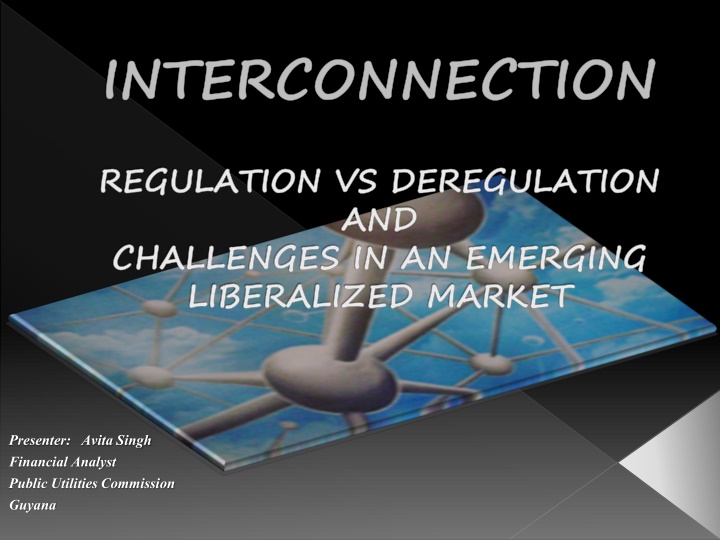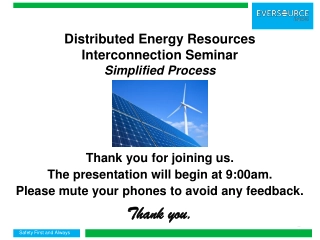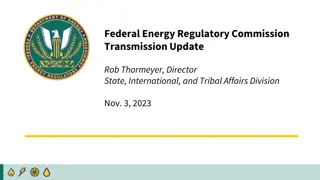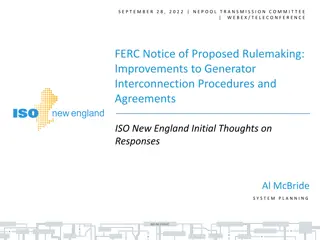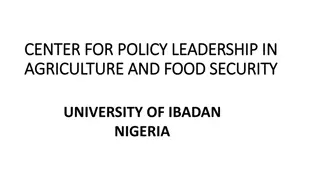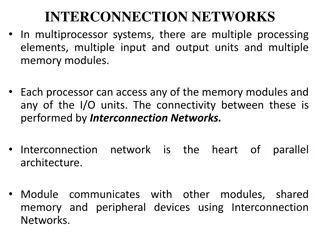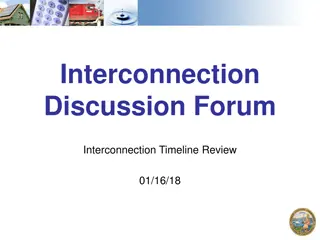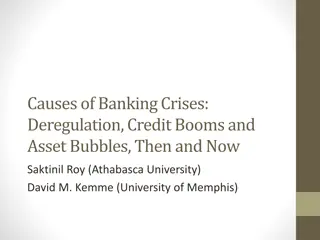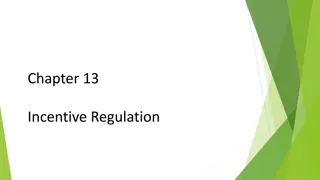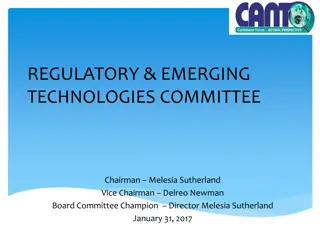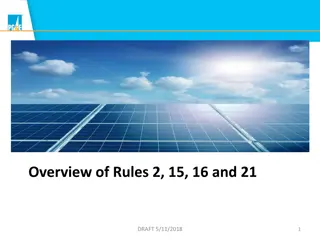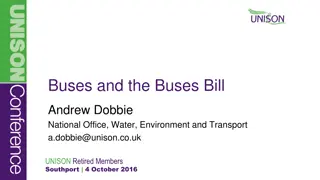Interconnection Regulation vs. Deregulation Challenges in an Emerging Liberalized Market
Interconnection between telecommunication networks and services plays a vital role in enhancing value for subscribers and facilitating the provision of a wide range of services. Regulation of interconnection is essential to protect competition, achieve social objectives, manage scarce resources, ensure compatibility, and prevent anti-competitive behavior by operators. Challenges arise when incumbent operators resist interconnection to limit competition and maintain market power.
Download Presentation

Please find below an Image/Link to download the presentation.
The content on the website is provided AS IS for your information and personal use only. It may not be sold, licensed, or shared on other websites without obtaining consent from the author.If you encounter any issues during the download, it is possible that the publisher has removed the file from their server.
You are allowed to download the files provided on this website for personal or commercial use, subject to the condition that they are used lawfully. All files are the property of their respective owners.
The content on the website is provided AS IS for your information and personal use only. It may not be sold, licensed, or shared on other websites without obtaining consent from the author.
E N D
Presentation Transcript
INTERCONNECTION REGULATION VS DEREGULATION AND CHALLENGES IN AN EMERGING LIBERALIZED MARKET Presenter: Avita Singh Financial Analyst Public Utilities Commission Guyana
TOPICS: Definition of Interconnection Why Interconnection is necessary Why Regulate Interconnection What is a Good Interconnection Regime Issues that should be dealt with in an Interconnection Agreement Approaches to Interconnection Rates Regulation Liberalization of the Telecoms sector in Guyana
WHAT IS INTERCONNECTION? Linking public telecommunications transport networks or services in order to allow the users of one communicate with users of another supplier and to provided by another supplier with suppliers, providing supplier to access services (Reference:- World Trade Organization)
WHY INTERCONNECT? Interconnection increases the value of a network to its subscribers by increasing the number of people they can call and the range of ICT services they can access. Interconnection increases the value of telecommunications services, or the range of services operators can provide, thereby increasing profitability. Allows for expansion or improvement in services that are valuable to customers.
WHY REGULATE INTERCONNECTION? 1. To protect competition Safeguard against anti-competitive conduct Safeguard against emergence of market structure not conducive to effective competition 2. To achieve some social objective Universal service not achievable through market forces alone
WHY REGULATE INTERCONNECTION? 3. To manage scare resources Radio spectrum Telecommunications numbers 4. To ensure compatibility and interoperability between telecommunications systems and to avoid interference and safety hazard 5. Each operator holds a monopoly for termination on its network.
WHY REGULATE INTERCONNECTION? In some circumstances telecommunications operators will interconnect voluntarily. However, sometimes incumbent operators will have little incentive to allow access to their network, and may seek to limit competition and preserve its market power by: Refusing to interconnect Offering interconnection at a price, or on other terms, that make it difficult for an efficient entrant to compete, or Seeking to sabotage the entrant by providing a lower quality interconnection service to the entrant than the incumbent provides itself.
WHAT IS A GOOD INTERCONNECTION REGIME? What is an Interconnection Agreement? The arrangements providers networks and services to enable customers to have access to the customers, services and networks of other service providers. (Reference:- International Telecommunications Union) commercial and which their technical service equipment, under connect
ISSUES THAT SHOULD BE DEALT WITH IN AN INTERCONNECTION AGREEMENT Prices and adjustment of price over time Points of interconnection Transport (conveyance) charges and traffic routing Quality of service standards Billing and collection Traffic measurement and settlement Numbering resources Forecasting network needs Access to customer information
APPROACHES TO INTERCONNECTION RATES REGULATION Interconnection rates are wholesale rates charged by a service provider for the use of its infrastructure by its competitors for the mutual benefit of the service providers and the consumers. Therefore charges of interconnection between the service providers should not cause a pecuniary burden to the consumer.
APPROACHES TO INTERCONNECTION RATES REGULATION A number of different procedures might be used to establish interconnection charges. These include: the regulator in advance determines the charges, together with other interconnection, using different approaches to price regulation; essential elements of the regulator sets guidelines which should be used for establishing the rates multilateral) negotiations among the operators; through (bilateral or operators set the rates through negotiation and commercial agreements, without the involvement of the regulators (the regulator intervenes only if parties fail to agree).
APPROACHES TO INTERCONNECTION RATES REGULATION Possible approaches to wholesale price Regulation: Rate of Return regulation (RoR) informs the level of profits that the regulated company may earn and on periodic reviews whether adjustments are required to tariffs to bring it in line with the ROR. Price-cap Rates or prices are adjusted each year by an index that reflects the overall rate of inflation in the economy. Sometimes a price ceiling approach might be used for the same purpose. Under this approach a regulator imposes a limit on how high a price can be charged on a service, without making periodical adjustments.
APPROACHES TO INTERCONNECTION RATES REGULATION Cost orientated or cost based pricing - prices should reflect their costs plus reasonable rate of return which operators are allowed to earn. Operators or regulators might use different cost bases (current cost, historical cost, forward-looking cost) and different methodologies (Fully distributed cost (FDC), LRIC) to determine the prices. International benchmarking establishing the price of a service based on prices in other jurisdictions. The outcomes of this regulation, however, depend heavily on adjustments made. Without appropriate adjustments, benchmarking interconnection rates that make little sense. can result in
APPROACHES TO INTERCONNECTION RATES REGULATION Retail minus interconnection charge will be equivalent to the retail tariff practiced by the operator less the costs avoided by not having to retail the service. The discount from retail prices is usually set as a fixed percentage of the retail price. It is widely acknowledged that retail minus implies a lower level of regulatory control than cost-based prices. Additionally, for competition is likely to emerge, and in cases where risky investments have been made or where markets are in the early stages of development, it has been suggested that retail minus would be preferable to LRIC prices. The outcome of this approach depends on the level of retail prices. This approach is usually used in the case of sufficient competition in downstream markets. markets where effective
LIBERALIZATION OF THE GUYANA TELECOMS MARKET Objectives of new regulations: Technological neutrality Preventing distortions and promoting competition Deliver maximum benefit for consumers (choice, price and quality of service)
NEW TELECOMS REGIME IN GUYANA 1. The current regime provides for three regulatory institutions (a) A Director of Telecommunications; (b) The Public Utilities Commission (PUC); (c) National Frequency Management Unit (NMFU) This arrangement will be replaced by two regulators, each with clearly delineated responsibilities and functions. Technical Regulator: A new telecommunications agency (into which the NFMU will be incorporated), will be responsible for regulating licensing, the spectrum and other technical aspects of the sector and for administering the universal access/universal services programme. Economic regulator: The PUC will be responsible for ensuring a competitive environment, interconnection and access between and among operators and service providers, and consumer rights ad regulating prices in certain instances.
NEW TELECOMS REGIME IN GUYANA 2. Harmonization of the Telecommunications Act and the PUC Act. 3. Expansion of telecommunications networks & telecommunications services into un- served and underserved areas & regions of the country through institution of new universal access/universal service programme.
NEW TELECOMS REGIME IN GUYANA: 4.Small operators and service providers will be issued clear, standardized licenses and frequency authorizations. 5. Transparency and non-discrimination in the issuance and monitoring of licenses and frequency authorizations e.g. model licenses & model frequency authorizations.
NEW TELECOMS REGIME IN GUYANA: 6. Distinction between dominant and non- dominant telecoms operators/service providers - clear rules for identifying or penalizing anti-competitive behaviours. 7. Comprehensive and enforceable rules for interconnection and access. 8. Prices will be set by the market place.
POSSIBLE IMPACTS OF THE NEW TELECOMS ACT Fairer competition which will lead to lower prices and better services for consumers Market Expansion Guyanese will be able to access areas that were hitherto unserved Investment in the increase The sector will employ more people and enhance Guyana s economic growth sector should
Thank You Questions??
